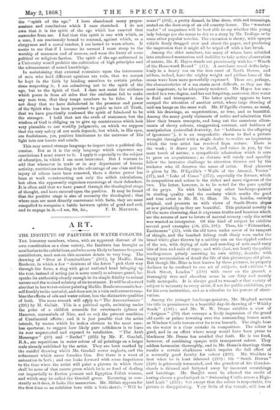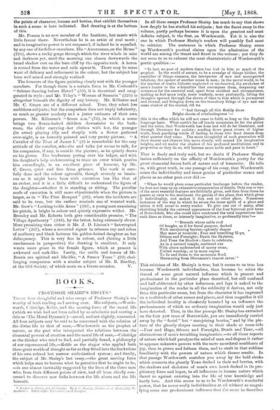ART.
THE INSTITUTE OF PAINTERS IN WATER COLOURS. THE honorary members, whom, with an apparent distrust of its own constitution as a.close society, the Institute has brought as auxiliaries to its exhibitions, and who seem likely to become frequent contributors, need notson this occasion detain us very long. The drawing of "Deer at Fontainebleau" (301), by Madlle. Rosa Bonheur, in which a few " denizens of the forest" pick their way through the ferns, a stag with great antlered head bringing up the rear, instead of acting (as is more usual) as advance guard, be- speaks its authorship clearly enough in its simple fidelity to animal nature and the trained sobriety of its treatment. It will be observed also that in her water-colour painting It. ladlle. Bonhenrcommits her- self frankly to the material, and does not,in a vain endeavour to com- bine the effects of oils and water colour, lose the distinctive qualities of both. The same remark will apply to " The Aneexationists " (291) by M. Gallait. This is a political squib, satirizing under the guise of a childish scramble for sweetmeats (plums of Hanover, marmalade of Nice, and so on) the present condition of Continental affairs ; and it is just possible that the artist intends, by means which he makes obvious to the most care- less spectator, to suggest how likely pure selfishness is to leave its rear unprotected and exposed to retaliation. " The Arab Messenger" (30) and " Rachel " (205) by Mr. F. Goodall, R.A., are repetitions in water colour of oil paintings on a larger scale already exhibited by the artist. They arc both marked by the careful drawing which Mr. Goodall never neglects, and the refinement which never forsakes him. But there is a want of animation in both ; and one looks forward with some impatience to the time when the artist will paint a picture in which there shall be none of that coarse green which he is so fond of dealing out impartially to Breton peasant and Egyptian Fellah Woman, and which may be called the Goodall green. Recurring so con- stantly as it does, it looks like mannerism. Mr. Millais appears for the first time as an exhibitor here with a little sketch, " Will he
the "spirit of the age." I have abandoned many prepos- come ?" (305), a pretty damsel, in blue dress, with red trimmings, sessions and conclusions which I once cherished. I do not seated ou the door-step of an old country-house. The "constant reader" of magazines will be best able to say whether this young lady belongs (as she seems to do) to a story by Mr. Trollope or by some other popular novelist. The execution is showy, with opaque vehicle freely dragged over and about the paper, and producing the impression that it might all be wiped off with a hat-brush.
Among the older members, too many of whom have subsided into confirmed mannerism and inability to take active observation of nature, Mr. E. Hayes stands out prominently with his " Wreck of the Homeward Bound" (41). A merchant vessel drifts help- lessly in a heavy sea on the iron coast of North Devon, and seldom, indeed, have the mighty weight and pitiless force of the ocean wave been more powerfully expressed. These are, perhaps, the characteristics of a sea storm most difficult, as they are the most important, to be adequately rendered. Mr. Hayes has suc- ceeded in a rare degree, and has not forgottep, moreover, that water is fluid and transparent. The latter quality appears to have escaped the attention of another artist, whose large drawing of mid-sea hangs on the same wall. Mr. D'Egville charms, as usual, with his drawings, so unpretentious, so true, and so beautiful. Among the many gaudy claimants of notice and admiration that blow their brazen trumpets, and hang out the conscious allure- ments of showy colours, exaggerated contrast, and boldness of manipulation (miscalled dexterity, for " boldness is the offspring of ignorance"), it is an unspeakable charm to find a picture wrought throughout with a single desire to realize an impression which the true artist has received from nature. There is the work ; it draws you to itself, and raises in you, by the mere touch of nature, a sympathetic admiration which is sure to grow on acquaintance ; as distaste will surely and speedily follow the intrusive challenge to attention thrown out by the trickster who ill deserves the name of artist. Real pleasure is given by Mr. D'Egville's " Walls of the Arsenal, Venice" (27), and "Lake of Como" (272), especially the former, which in composition and colour is the richer and more vigorous of the two. The latter, however, is to be noted for the pure quality of its greys. No whit behind any other landscape-painter in sterling quality and the modesty which marks the good and true artist is Mr. H. G. Hine. Ile is, besides, entirely original, and presents us with views of South-Down slopes as new pictorially as they arc beautiful. This pictorial novelty is all the more charming, that it expresses truths and beauties which are the reverse of new to lovers of natural scenery : only the artist was wanted as interpreter. Of this kind of subject he exhibits several good examples (38, 255, 281). Then, his " Fishmarket, Eastbourne" (33), with the old town under cover of its rampart of shingle, and the beached fishing craft dimly seen under the broad white glare thrown by a midday sun on the rippled surface of the sea, with drying of sails and mending of nets amid rusty bits of iron and coils of rope ; and with (last, not least) the public reading-room primly asserting its own utility, describe with happy accumulation of detail the life of this picturesque old place. But though Mr. Hine is best known by these pictures, he properly declines to be confined to one set of subjects, and exhibits " A Back Street, London " (309) with snow on the ground, a thoroughly true and cheerless scene in our dirty and meanly built metropolis. It is always good to remember that variety of subject is necessary to every artist, if not for public exhibition, yet for his own instruction, and as a stimulus to his powers of obser- vation.
Among the younger landscape-painters, Mr. Mogford asserts his title to prominence in a beautiful day-lit drawing of " Whitby Sands" (186) ; and Mr. W. W. Deane exhibits a view of " Avignon " (79) that conveys a lively impression of the grand old castle or palace towering over the surrounding houses much as Windsor Castle towers over its town beneath. The single boat on the water is a clear mistake in composition. The colour is good, and in an effect where many would have been prone to blackness Mr. Deane has avoided that fault. Ile is too fond, however, of combining opaque with transparent colour. They seldom harmonize thoroughly, and in Mr. Deane's drawings there results a certain chalkiness which impairs the full effect of a naturally good faculty for colour (239). Mr. Shalders is best when he is least laboured (210) : his "South Downs" (128) is grievously tormented, and the grandeur of his thunder- clouds is thinned and frittered away by incessant scratchinga and hatchings. Mr. liariitt must be allowed the credit of having chosen a good subject in " Swimming Cattle across a High- land Loch " (253) ; bat except that the colour is respectable, the picture is disappointing. Very little of the tumult, still less of the points of character, human and bovine, that exhibit themselves in such a scene is here indicated. Bad drawing is at the bottom of this.
Mr. Penson is no new member of the Institute, but meets with little favour there. Nevertheless he is an artist of real merit ; and in imaginative power is not surpassed, if indeed he is equalled, by any one of his fellow-members. His "Auseremme,on the Meuse" (224), shows a rocky gorge through which the river winds in mist and darkness yet, until the morning sun chases downwards the broad shadow cast on the bare cliff by the opposite rock. A heron is roused from the water and sails upwards. There may be some want of delicacy and refinement in the colour, but the subject has been well seized and strongly realized.
The honours of the figure-painting clearly rest with the younger members. For though there is a certain force in Mr. Corbould's " Salome dancing before Herod " (53), it is theatrical and exag- gerated in style ; and Mr. Tidey's " Woman of Samaria " (225) is altogether beneath the dignity of any history. Mr. Kilburne and Mr. C. Green are of a different school. True, they select less ambitious subjects ; but the comparison does not imply inferiority, so much as greater modesty and a juster estimate of their own powers. Mr. Kilburne's " Seven a.m." (76), in which a nurse brings two flaxen-haired children downstairs to the bath- room, the elder carrying •her clothes with her, the younger (in arms) playing idly and sleepily with a flower gathered over-night, is an honestly painted and very pretty picture. " A Cavalier of the Time of James L" (2) is remarkable for the easy attitude of the cavalier,.who sits and talks (or seems to talk, for his companion, if any, is outside the picture), as he quietly draws on his gloves. The tradesman poring over his ledger, and with his daughter's help endeavouring to trace an error which puzzles him exceedingly, is an excellent piece of humour, by Mr. C. Green, quiet and free from grimace. The work is care- fully done and the colour agreeable, though scarcely so lumin- ous as it might have been with execution less like that of an etcher, and it is a little difficult to understand the figure of the daughter—whether it is standing or sitting. The peculiar mode of execution is still more objectionable when the picture is larger, as in " The First Bouquet " (36), where the incidents are said to be true, but the surface reminds one of worsted work. Mr. Gow's " Looking to his Arms " (283), a young man examining his pistols, is bright in colour and quietly expressive withal. Mr. Bromley and Mr. Roberts both give considerable promise, " The Village Apothecary " (248), by the latter, being extremely clever. More promising than either is Mr. J. D. Linton's " Intercepted Letter" (267), where a reverend signor in crimson cap and robes of mulberry and black lectures his golden-haired daughter on her delinquency. This is very flue in colour, and (bating a little carelessness in perspective) the drawing is excellent. It only wants more grace in the female figure, which at present is awkward and sack-like. Lastly, the cattle and horses of Mr. Beavis are spirited and life-like, "A Sussex Team" (93) chal- lenging comparison with a similar subject of Mr. B. Bradley, at the Old Society, of which more on a future occasion. V.



































 Previous page
Previous page